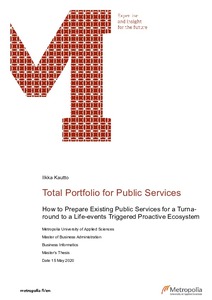Total Portfolio for Public Services : How to Prepare Existing Public Services for a Turnaround to a Life-events Triggered Proactive Ecosystem
Kautto, Ilkka (2020)
Kautto, Ilkka
2020
All rights reserved. This publication is copyrighted. You may download, display and print it for Your own personal use. Commercial use is prohibited.
Julkaisun pysyvä osoite on
https://urn.fi/URN:NBN:fi:amk-2020051912188
https://urn.fi/URN:NBN:fi:amk-2020051912188
Tiivistelmä
Public services have primarily been managed with the same principles as first described in the 18th century by a French economist, Jacques de Gournay, the inventor of bureaucracy. These principles originally introduced better efficiency in public operations, creating structure through professional operating and use of fixed rules. However, digitalization has changed the rules and forced many business sectors to react constantly and be driven by customer demand and delight. It has recently placed the same challenge to the bureaucracy based public service operations. Hence, the purpose of this Master’s thesis was to identify and describe a required portfolio management setup for driving a public service turnaround towards the digital era.
The study was conducted as a mixed method developmental research comprising a desktop study, literature review, qualitative interviews and benchmarks. Interviews and benchmarks comprised the interviewees from the city of Helsinki, cities of Espoo and Turku, as well as Ministry of Finance, Finland and National Population Register. In addition, Estonian digital services were benchmarked.
The current state analysis revealed that there is substantial potential in improving the case organization’s service recognition and in focusing them on customer situations where they deliver most of their value. The analysis also identified the improvement areas related to developing the service base by outlined strategies as well as in sourcing assets.
As the outcome, the author has created a recommended business wheel concept describing the related operational business dynamics. The recommendation includes a set of required portfolios and a necessary organizing proposal. The author has demonstrated the pivotal role of an offering-based service management, when turning around disparate public services to a life-events triggered coherent service ecosystem. The author has also outlined the ways of focusing the public service offering to customer demand and harnessing Artificial Intelligence. In addition, the author has outlined the ways to set up necessary innovation capability using customer oriented and lean practices. Finally, the author has outlined the related ways of improving the operational process performance.
The study was conducted as a mixed method developmental research comprising a desktop study, literature review, qualitative interviews and benchmarks. Interviews and benchmarks comprised the interviewees from the city of Helsinki, cities of Espoo and Turku, as well as Ministry of Finance, Finland and National Population Register. In addition, Estonian digital services were benchmarked.
The current state analysis revealed that there is substantial potential in improving the case organization’s service recognition and in focusing them on customer situations where they deliver most of their value. The analysis also identified the improvement areas related to developing the service base by outlined strategies as well as in sourcing assets.
As the outcome, the author has created a recommended business wheel concept describing the related operational business dynamics. The recommendation includes a set of required portfolios and a necessary organizing proposal. The author has demonstrated the pivotal role of an offering-based service management, when turning around disparate public services to a life-events triggered coherent service ecosystem. The author has also outlined the ways of focusing the public service offering to customer demand and harnessing Artificial Intelligence. In addition, the author has outlined the ways to set up necessary innovation capability using customer oriented and lean practices. Finally, the author has outlined the related ways of improving the operational process performance.
